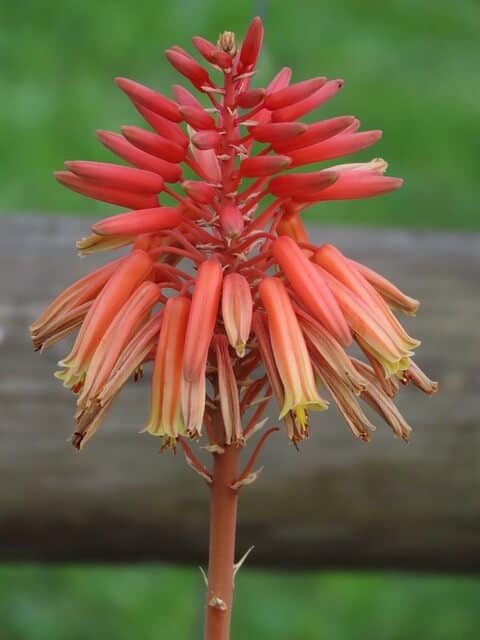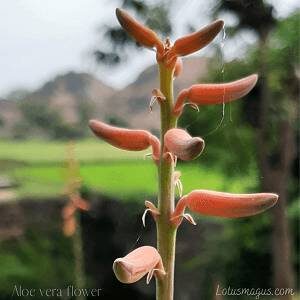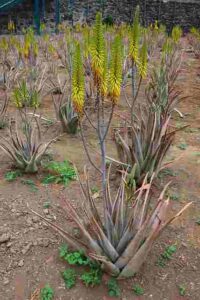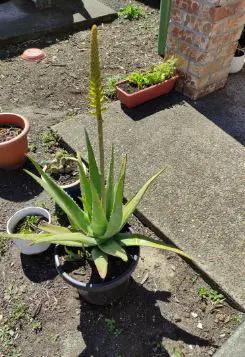If you are searching for whether Aloe Vera blooms or not, is this succulent actually giving flowers, how flowers look and when and how can I make my Aloe Vera Flower bloom? There are many questions which might arise. I am here to answer all those questions.
Aloe Vera flowering is possible if it gets warm temperature, proper nutrition in the potting soil mix, caring, watering on time, and the aged factor. These plants bloom when they become older and some leaves might die because they get old but there is the time when Aloe Vera flower stalks might bloom.It is still rare that it can bloom once a year but we can still try and do our best. If Aloe Vera flowers die then cut those flower stalks from bottom as they may have only all nutrients so cutting would enhance the growth of other stalks and leaves of Aloe Vera.
Aloe Vera has healing properties as well as unique producing flowers that most don’t know if it can bloom. Blooming in aloe can be rare but it’s possible in heated or warm climate areas where it gets the right environment to flourish.
What do you do with an Aloe Plant after flowering?
Once an Aloe Plant completes the flowering and starts to dry then cut down the flower stalks from the bottom or base as these flowers won’t grow back and it will only take nutrients from existing soil.This will not damage your aloe plant but encourage it to grow more leaves. You may also notice some of the aloe plant leaves that are growing outside become dry or dying. This is because they have turned older and it’s common as they might change to brown. So pruning those aloe leaves will again make your succulent plant more happy and get rid of any disease.
As an Amazon Associate we earn from qualifying purchases.
Table of Contents
also I suggest removing brown leaves from aloe plant is important because they don’t look good and invites various insects like mealy bugs and mites. If Aloe Vera gets light good amount of light everyday it will surely grow taller. For winters try not to overwater them and let them grow on their own. Water only if they have dry soil. In summer it’s just the opposite , you need to give them water and place them in a good sunlight area.
Does Aloe Vera die after flowering?
The Short answer is No, Aloe vera won’t die after flowering and it will continue to grow just like other Tropical, semi-flowering plants grow. Aloe vera flower blooms may die by getting dried and old, it’s limited to 3-4 months only and because it only blooms till late summer after Aloe blooms for the first time in early spring.
Aloe plants are healthy succulents and they don’t easily die by flowering, even if they tolerate the hot sunlight in deserts.
The flower stalks you just need to prune in from base and aloe plants are good to grow. Generally aloe flowers are red-yellowish in color and vertically stand with the thick robust flower stalk and you can also call it flower stem.
These flowering won’t harm the aloe plant anyway but yes if you do late in cutting back those flower stalks it will keep absorbing all the nutrients from the soil so better prune it.
Also if you don’t want to cut the flower stalks then leave it, it will naturally dry and die back but your aloe plant will continue to grow as it is growing before the flowering.


How often do Aloe Vera plants bloom?
Aloe vera plants bloom once a year and you might see the flower stalks start developing in spring & bloom but many people rarely any Aloe Vera bloom as most of us have the plant growing near the window, televisions or adjacent to the laptops or even in bedrooms or hall. To Answer this why it doesn’t bloom I researched & found out that there are certain conditions required to get this Aloe Vera bloom.
Those conditions are favorable for an environment like warm temperature, Nutrient rich soil (it simply means fertilizer use), Aloe should be aged and become big with thick leaves and lots of sunlight and don’t think it will bloom inside the house. Outside their might be something called pollination will happen between flies and flower stalk that could lead to flower blossom.
but most important it’s the climate and the age of the plant, even small pot doesn’t result in flowering of Aloe Vera. You need to change the pot many times over the years and one day it will bloom once it gets all the environmentally friendly place and gets aged.
USDA Zone 9 to 12 are best to grow aloe plant blooms as there is more heat and warm climate than the lower zones. Using fertilizer that is rich in phosphorus can bring good colors to Aloe Vera plants and may help aloe to produce flower stalks. Flower blooms have yellow to orange color and I may put a video to make sure you get a view of Aloe Vera plants generally called aloe plants.
Here is the 15-30-15 fertilizer : Buy from Amazon.
15-30-15 is the ratio of Nitrogen, Phosphorus and Potassium.



How long does an aloe vera flower last?
Aloe vera flowers can last till late summers and it’s rare to see those vertically spiky blooms. Many People saw Aloe plant stalks come in early spring and some say it may bloom at the end of spring. These factors may be because zones like zone 12 may see aloe plants bloom early while USDA zone 9 and 10 may see flowering in mid to late spring.
Aloe plants bloom only for 2-3 months once in a year after that they dry and drop. So you should prune them as they will only use the nutrient of soil so cutting flower stalks from base will help your Aloe Vera recover from the leaves that are already dried and browned. As leaves get old newer leaves replace them which means its soil should be capable of providing the plant all the nutrients if the soil has all the nutrients used , then it makes the entry of flowering fertilizers that may help the Aloe Vera bloom.
How to get my aloe plant to flower?
Aloe vera flowers are known for their medicinal properties and their ability to thrive in harsh conditions. However, they can be notoriously challenging to coax into blooming. If you’re eager to see your aloe vera plant burst into beautiful flowers, there are several key factors to consider.
Light
Aloe vera plants require a minimum of 6 hours of direct sunlight each day to bloom. If your plant isn’t receiving sufficient sunlight, its chances of flowering diminish. In regions with shorter daylight hours, you might need to supplement natural light with a grow light.
Water
Aloe vera plants are hardy and can withstand drought conditions but are vulnerable to overwatering. To encourage flowering, water your aloe vera only when the soil is completely dry. Avoid overwatering, as it can lead to root rot.
Temperature
Aloe vera plants thrive in warm temperatures, ideally ranging from 70 to 85 degrees Fahrenheit (21 to 29 degrees Celsius). If you live in a region with cold winters, consider bringing your aloe vera plant indoors during the winter months.
Fertilizer
Aloe vera plants require fertilizer to bloom. Apply a balanced fertilizer to your plant once a month during the growing season. Be cautious not to over-fertilize, as this can harm the roots.
Here are some additional tips to enhance the likelihood of your aloe vera plant flowering:
Choose the Right Pot
Select a pot with drainage holes to prevent root rot. Ensure that the pot is spacious enough to accommodate the plant’s root system.
Use Well-Draining Potting Mix
Aloe vera plants need a potting mix that provides excellent drainage. You can opt for a commercial succulent potting mix or create your own blend by combining equal parts potting soil, sand, and perlite.
Repot Regularly
As your aloe vera plant grows, repot it into a larger container every 2 years or when it becomes rootbound.
Remove Dead Leaves and Offsets
Regularly remove any dead leaves or offsets from your aloe vera plant. This practice promotes new growth and flowering.
With proper care and attention, you can encourage your aloe vera plant to bloom. Keep in mind that patience is key, as aloe vera plants may take some time to mature and initiate flowering.
Morning sunlight is best for leaves as well as flowers so 9 to 11 is the best time to put them outside in sunlight and bring them back after 11-12am because you don’t want aloe leaves getting sunburnt. Make sure when giving sunlight daily it might need more water and don’t make mistakes by overwatering aloe plant excessively. Always check soil for dryness before giving more water.
One thing That I noticed is that the flowers are very similar to red hot poker plants. You should check my post and see for yourself.

Different Types of Aloe Vera Plants and Which Ones Are Most Likely to Bloom
Aloe vera encompasses over 500 diverse species, not all of which are known for their flowering capabilities. However, some aloe vera species are more likely to bloom than others. Here’s a list of some common aloe vera plants that are renowned for their blooming tendencies:
Aloe barbadensis

Aloe barbadensis, also known as aloe vera, is the most prevalent type of aloe vera plant. It’s a succulent with thick, fleshy leaves typically green or blue-green in color. Aloe barbadensis plants have medicinal properties and can indeed bloom, although it’s not guaranteed. When they do flower, they produce yellow or orange blossoms.
Aloe arborescens

Aloe arborescens, also called the candelabra aloe, is a tree-like aloe vera plant that can grow up to 10 feet tall. Its long, slender leaves are typically green or blue-green. Aloe arborescens is renowned for its beautiful red or orange flowers, clustered at the tips of its branches. It’s relatively easy to cultivate and tends to bloom more reliably than other aloe vera species.
Aloe aristata

Aloe aristata, known as the lace aloe, is a compact aloe vera plant, usually reaching a height of about 6 inches. It features short, thick leaves with green or blue-green coloration and white edges. Aloe aristata plants have distinctive appearances and produce lovely orange flowers in clusters on tall stalks. They are relatively easy to grow and are among the dwarf species of aloe vera that tend to bloom more reliably.
Other aloe vera species known to bloom include:
- Aloe ciliaris
- Aloe ferox
- Aloe variegata
- Aloe mitriformis
- Aloe plicatilis
- Aloe aculeata
It’s essential to note that not all aloe vera plants of the same species will bloom, even with identical care. While certain aloe vera species are more likely to bloom, there’s no absolute guarantee. If you aim to encourage flowering, consider selecting species like Aloe arborescens or Aloe aristata that are known for their blooming tendencies.
What does the flower of an aloe plant look like?

Aloe plant flower look like multiple separate tubes in round, pipe shaped. Aloe blossom grown from flower stalks in vertical direction but aloe plant flower tuber bells can grow downward and the aloe flower is similar to inverted U shaped. These flowers in aloe have orange, redish, yellowish and white color.
These flowers do attract birds, bees, flies which help the plant flower stalks take part in pollination and our aloe plant can bloom after that. Birds generally sit on these flower stalks to rest and even drink nectar from the plant.
The leaves in aloe vera look like spiky, thick, watery filled greenish in color and they store water so it can tolerate dry days even without water. These aloe plants are found in desert areas and this is why it is capable of adjusting to many environmental conditions.
Aloe flower can bloom early in zone 10-12 as the warmer the temperature the more growth it is able to produce. If you ever try to grow them in winters it is highly doubtful as these plants hate wet climatic conditions and we know that aloe grows best in warm areas not in freezing cold areas.
Do Aloe Vera flowers have a scent?
Aloe vera flowers have no smell, birds and bees come to these flower to sit or for pollination. These orange tubular pipe-like shaped clusters makes the whole flower in round shape. Smell of aloe flower is not obnoxious or unacceptable so don’t worry about its scent. While inside of its green spiky leaves you may notice the gel having an odor that is unwelcoming like rotten potatoes, garlic , onions these are the smell people generally get. Mostly you may get a rotting scent in Aloe Vera plant but its gel is very powerful in healing properties so it’s better for our skin this is the reason it is very popular among womens especially.
Aloe vera gel is sticky, not smooth, it’s transparent and hardened. Even in hot boiling water the juice of aloe plants hardly separated.
Do all Aloe Vera plants bloom?
No, Not all Aloe vera blooms, many people have commented that their aloe plants are not blooming as they were growing it for many years. There are many varieties of aloe plant which rarely bloom and it is not common in these plants, saying it can bloom once every year but in reality blooming can only occur if it enjoys the environment and soil nutrients. Yes they want a better climate like if it is warmer in zones 10-12 and they are more likely to bloom in those USDA zones.
While the placement of this plant is also important as where you have placed it as they want most light from the sun and the soil should be nutrient rich to enhance the Aloe Vera ability to flower.
When providing the right conditions & proper care that does magic and surely aloe will produce tubular shaped flowers. These blooms can only occur in older aloe plants and younger plants don’t have much energy to build the new flowers. Blooming of flowers in Aloe Vera might happen at the start of the spring and can work till summer.
For fertilizing your aloe plant, Apply liquid fertilizer in the summer season that is the best for most of the flowering plants & semi flowering plants like Aloe Vera.
Color of these blooms can be seens as orange to yellow and you might see another color with another variety that looks similar to our aloe plant.
Is Aloe Vera flower lucky?
Aloe Vera flower doesn’t have any significance or association with luck but as a whole aloe vera plant it can bring good luck, cheerfulness as this plant has amazing healing properties may relieve burns, useful in skin problems like rosacea and wounds.
According to Healthline, it can improve the skin from getting dry, and has an anti-inflammatory property that works for wound recovery. It is even said to be effective for acne.
Helpful Note: Aging can be slowed if you can lower the sugar intake.
There are plants that can bring more pure air with good luck as they are considered feng shui plants.
- Money Plant
- Snake plants
- Jade Plants
- Lucky Bamboo
- Palms
- Orchids
- and many more.
Some plants can remove bad air from the indoor environment and some are termed as lucky as they have purifying capability and have benefits that can be useful to today’s era.
The list above are best companion plants for our aloe vera plant if you just started a new gardening room full of plants that differ from each other. Mostly we grow indoor plants that have good vibes, are natural, easy to care for, remove toxic air and much more.
Can you eat Aloe Vera flowers?
No, Aloe Veraflower is not edible as there is no trustable source that can confirm whether it can be eaten by humans or any pet. generally when people search they use leaves of aloe vera , yes that are edible according to healthline & safe to eat even the gel is used in skin healing.
Even Aloe Vera gel that is present in its leaves can be mixed with warm water would solve your stomach problems like constipation according to healthline while it has antioxidants that reduce ricky diseases like cancer according to webmd.
It also contains vitamins that are very important to our body like vitamin C,B, E and folic acid so basically these nutrients are packed in Aloe Vera leaves.
But still there is a problem if consumption is for a long time of aloe water as the kidney might get issues, heart problems, stomach cramps and much more. So don’t take too much of it.
About Aloe Vera Flower
Aloe Vera (Aloe barbadensis miller), a succulent plant with therapeutic and decorative uses, produces flowers. Aloe Vera, native to the Arabian Peninsula, is farmed worldwide for its adaptability and health benefits.
Aloe Vera flowers grow on tall, thin stalks that may exceed 3 feet. The raceme-shaped blooms are tubular. They attract bees, birds, and butterflies with their yellow, orange, or red colors. Aloe Vera blooms in late winter to early spring, depending on environment and growth circumstances.
How to Grow Aloe Vera Flowers
Aloe Vera flowers need proper maintenance and atmosphere. Steps:
- Locate properly: Aloe Vera likes sunny, well-drained soil. Outdoor planting requires at least 6 hours of sunshine every day. Place indoor plants near a sunny south- or west-facing window.
- Aloe Vera thrives on sandy or gritty well-draining soil. Succulent or cactus soil is best. Add perlite, pumice, or coarse sand to increase drainage.
- Aloe Vera plants need water to grow and bloom. Water deeply after the soil dries out. Reduce winter watering to prevent root rot.
- Aloe Vera plants need little fertilizer. Apply diluted, balanced fertilizers like 10-10-10 or 8-8-8 once or twice a year throughout the growth season.
- Aloe Vera plants prefer 55-80°F (13-27°C). They can withstand short cold periods, but continuous exposure to temperatures below 50°F (10°C) may kill the plant.
- To promote growth, prune and divide. If your Aloe Vera plant is growing congested, split it by separating the pups and repotting them.
What Are the Benefits of Growing Aloe Vera Flowers?
- Aloe Vera is calming, therapeutic, and anti-inflammatory. The leaves’ transparent gel treats burns, sunburns, skin irritations, and other minor ailments.
- Aloe Vera plants absorb formaldehyde and benzene to purify indoor air.
- Aloe Vera plants give architectural beauty to your yard or interior environment. Blooming flowers provide color.
- Minimal maintenance: Both rookie and professional gardeners can care for aloe vera plants.
- Attract pollinators: Aloe Vera plants’ tubular blossoms attract bees, butterflies, and hummingbirds, supporting local ecosystems and garden biodiversity.
- Drought-tolerant: Aloe Vera plants thrive in dry climates. They are ideal for xeriscaping or water-wise gardening.
- Aloe Vera plants are therapeutic, decorative, and air-purifying. Its adaptability makes them useful in any house or garden.
What Are the Uses of Dried Aloe Vera Flowers?
Dried aloe vera plants may be used for plenty of functions, together with:
- Medicinal use: Dried aloe vera vegetation can be used to make a tea that has anti inflammatory, pain-relieving, and wound-restoration houses.
- Cosmetic use: Dried aloe vera plants may be used to make a facial toner that can assist to lessen acne and infection.
- Aromatherapy use: Dried aloe vera vegetation may be used to make a potpourri or incense that has a calming and relaxing heady scent.
Medicinal makes use of of aloe vera plant life
- Reduce infection: Aloe vera plants contain compounds that can assist to reduce inflammation. This may be useful for people with situations inclusive of arthritis, psoriasis, and eczema.
- Relieve ache: Aloe vera flora also can assist to alleviate pain. This is due to the presence of compounds that have analgesic residences.
- Promote wound restoration: Aloe vera plant life incorporate compounds which can help to sell wound healing. This is due to their antibacterial and anti-inflammatory properties.
Cosmetic uses of aloe vera vegetation
- Reduce zits: Aloe vera flowers contain compounds which could assist to lessen pimples. This is because of their antibacterial and anti inflammatory residences.
- Reduce irritation: Aloe vera plant life also can assist to lessen inflammation of the skin. This can be useful for human beings with situations along with rosacea and eczema.
- Moisturize the skin: Aloe vera flora incorporate compounds that may help to moisturize the skin. This can make the skin sense soft and smooth.
Aromatherapy makes use of of aloe vera plant life
- Calming and relaxing scent: Aloe vera plant life have a moderate, candy heady scent that may be calming and enjoyable. This can be beneficial for those who are careworn or stressful.
- Uplifting heady scent: Aloe vera plants also can have an uplifting fragrance. This can be useful for folks who are feeling tired or lethargic.
Troubleshooting Common Problems with Aloe Vera Blooms
Despite providing the right care, your aloe vera plant may still fail to bloom. Several common issues could be preventing it from flowering. Here are some of the most frequent reasons:
Not Enough Sunlight
Aloe vera plants require a minimum of 6 hours of direct sunlight daily to bloom. If your plant isn’t getting adequate sunlight, it’s less likely to produce flowers.
Not Enough Water
While aloe vera is drought-tolerant, it still needs regular watering. However, overwatering can harm the roots and inhibit blooming. Ensure the soil dries out completely between waterings.
Not Enough Fertilizer
Aloe vera plants need appropriate fertilization to bloom. Apply a balanced fertilizer once a month during the growing season to promote flowering.
Plant Age
Aloe vera plants typically don’t bloom until they’re at least four years old. If your plant is younger, it’s less likely to produce flowers.
Stress
Aloe vera plants can experience stress due to various factors, including pests, diseases, and environmental changes. Stressed plants are less likely to bloom.
Here are troubleshooting tips for common issues with aloe vera blooms:
- Insufficient Sunlight: Relocate your plant to a spot with at least 6 hours of direct sunlight daily, or use a grow light to supplement natural light.
- Inadequate Water: Water your plant regularly, but avoid overwatering. Let the soil fully dry between watering sessions.
- Lack of Fertilizer: Apply a balanced fertilizer once a month during the growing season.
- Plant Age: Be patient if your plant is not yet four years old; it may need more time to mature.
- Stress: Identify and address the source of stress promptly. If pests or diseases are present, treat them accordingly. Adjust environmental conditions to make them more suitable for your plant.
Additionally, here are tips for dealing with pests and diseases that can affect aloe vera blooms:
- Mealybugs: Eliminate mealybugs by using a cotton swab dipped in rubbing alcohol or a mixture of insecticidal soap and water.
- Scale: Remove scale insects with a cotton swab soaked in rubbing alcohol or by using a horticultural oil and water spray.
- Fungal Diseases: To combat fungal diseases causing brown or black spots on aloe vera leaves, use a fungicide spray.
By following these guidelines and troubleshooting tips, you can address common problems that may hinder your aloe vera plant from blooming and help it produce exquisite flowers.
FAQ
What month does aloe vera flower?
Aloe Vera flowers from late winter to early spring, depending on environment and growth circumstances. Some locations bloom in January, while others wait until March or April.
How do I get my aloe plant to flower indoors?
Aloe Vera plants may blossom inside, although it’s harder than outside. Flowering tips:
Put your Aloe Vera plant in a south- or west-facing window that gets at least six hours of direct sunlight every day.
Aloe Vera plants prefer 55-80°F (13-27°C). Maintain this range inside.
Water thoroughly after letting the soil dry up. Overwatering causes root rot and limits blooming.
Fertilize sparingly: Apply a diluted, balanced fertilizer once or twice a year throughout the growth season to supply blooming nutrients.
Wait: Aloe Vera plants take years to bloom. Younger or freshly repotted plants may not blossom until they establish themselves.
Final words
I hope you like our article on Aloe vera flower that is still a rare bloomer and yes you can make it possible by following my guide what is needs and what is not and how you can make it bloom.
Also Read Related posts:
How to Harvest and Use Aloe Vera Gel A Step by Step Guide
32 Types of Aloe Plants – Which One is Best(With Pictures)
The History and Folklore of Aloe Vera Myths Legends and Cultural Significance
A Beginners Guide to Growing Aloe Vera Tips and Tricks for Success
Aloe Vera Flowers Uses and Medicinal Benefits
Is Aloe Vera Flower Luck? – Know The Reason Behind It?
Aloe Vera Meaning (What Does It Symbolize Spiritually In Different Cultures?
Aloe Vera Flowers Uses and Medicinal Benefits
Aloe Vera Plant Care – 5 Tips to Grow Them Indoors
Can You Freeze Aloe Vera Plant – Store and Preserve Gel, Leaf
Leggy Aloe Vera – Stem Too Long(How to Fix), Repotting Plant
Plants that Look Like Aloe Vera – 7 Similar Succulent(Pictures)
Can Aloe Vera Grow Without Sunlight? – (How Much Sun Does It Need)
Best Soil for Aloe Vera – Miracle Grow or Regular Potting Mix?
Aloe Humilis (Spider Aloe) – Care, Propagation, Benefits
Why Your Aloe Plant Fell Apart: Overwatering and How to Fix It
© 2024 Lotusmagus.com. All rights reserved. This content is protected by copyright. Visit Lotusmagus.com for more information.
